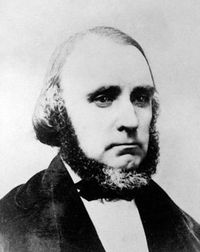| William Clayton | |
|---|---|
 | |
| Member and Clerk of the Council of Fifty[1] | |
| March 11, 1844 – December 4, 1879 | |
| Called by | Joseph Smith |
| Personal details | |
| Born | July 17, 1814 Penwortham, Lancashire, England, United Kingdom |
| Died | December 4, 1879 (aged 65) Salt Lake City, Utah Territory, United States |
| Resting place | Salt Lake City Cemetery 40°46′37.92″N 111°51′28.8″W / 40.7772000°N 111.858000°W |
| Known For | An early leader in the Latter Day Saint movement, clerk and scribe to Joseph Smith, and credited with inventing a version of the modern odometer |
| Spouse(s) | 10 |
| Children | 42 |
| Parents | Thomas Clayton and Ann Critchley |
| Signature | |
 | |
William H. Clayton (July 17, 1814 – December 4, 1879[2]) was a clerk, scribe, and friend to the religious leader Joseph Smith. Clayton, born in England, was also an American pioneer journalist, inventor, lyricist, and musician. He joined the Church of Jesus Christ of Latter Day Saints in 1837 and served as the second counselor to the British mission president Joseph Fielding while proselyting in Manchester. He led a group of British converts in emigrating to the United States in 1840 and eventually settled in Nauvoo, Illinois, where he befriended Joseph Smith and became his clerk and scribe. He was a member of the Council of Fifty and Smith's private prayer circle.
Clayton participated in plural marriage before it was practiced openly. His first plural wife was Margaret Moon, his sister-in-law, whom he married in 1843. He eventually married ten women, although three of his wives left or divorced him. He had at least 42 children by these wives. He moved to Winter Quarters in 1846 and wrote the words for the hymn "Come, Come, Ye Saints". He was a member of the first company to make the overland trek to the Salt Lake Valley, where he collaborated to devise a roadometer to measure distances for his The Latter-Day Saints' Emigrants' Guide.
Clayton's journals are an important resource for historians in Mormon studies. Clayton's journals were used as a source for Joseph Smith's History of the Church and for two sections of the Doctrine and Covenants. Three of Clayton's notebooks from when he lived in Nauvoo have been part of the closed archive of the Church History Department for the Church of Jesus Christ of Latter-day Saints (LDS Church). Jerald and Sandra Tanner published portions of the Clayton journals that appeared in the notes of a Brigham Young University student in 1982. George D. Smith relied on this copy to publish his An Intimate Chronicle: The Journals of William Clayton. James B. Allen, who made a transcript of the Nauvoo diaries when he worked in the LDS Church's History Division under Leonard Arrington, published more text from the Nauvoo journals in his reprint of his William Clayton biography entitled No Toil Nor Labor Fear. The LDS Church History Library announced in October 2017 that they would publish William Clayton's complete diaries.
- ^ Quinn, D. Michael (1980). "The Council of Fifty and Its Members, 1844 to 1945" (.pdf). BYU Studies. Provo, UT: Brigham Young University: 22–26. Retrieved October 4, 2011.
- ^ Cite error: The named reference
JSPwas invoked but never defined (see the help page).